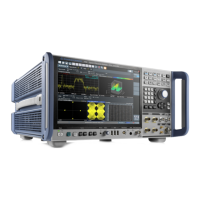Measurements and Results
R&S
®
FSW
268User Manual 1173.9411.02 ─ 43
2. Split the frequency span of the measurement into ranges for signal parts with simi-
lar characteristics.
Starting from the center frequency, determine which sections of the signal to the
left and right can be swept and monitored using the same parameters. Criteria for
such a range definition may be, for example:
● The signal power level
● The required resolution bandwidth or sweep time
● Transducer factors
● Permitted deviation from the defined signal level, i.e. the required limit values
for monitoring
If the signal consists of a transmission channel and adjacent channels, the channel
ranges can usually be used for the range definition.
3. If the signal power level to be monitored varies and the limits vary, define power
classes. For each range of levels that can be monitored in the same way, define a
power class.
a) Select the "Overview" softkey.
b) Select the "SEM Setup" button.
c) Switch to the "Power Classes" tab.
d) To add a power class, select the "Add" button.
e) Enter the start and stop power levels to define the class.
f) Select the power classes to be used for the current measurement:
● a specific class
● all classes, to have the required class selected automatically according to
the input level measured in the reference range
4. Select the "Sweep List" tab of the "Spectrum Emission Mask" dialog box.
5. Insert the required ranges using the "Insert before Range" and "Insert after Range"
buttons, which refer to the currently selected range (the reference range by
default).
If the signal trace is symmetric to the center frequency, activate the "Sym Setup"
option to make setup easier and quicker.
6. Define the measurement parameters for each range as required. If symmetrical
setup is activated, you only have to configure the ranges to one side of the center
range.
In particular, define the limits for each range of the signal, i.e. the area in which the
signal level can deviate without failing the limit check. If several power classes
were defined (see step 3), define limits for each power class.
a) Define the type of limit check, i.e. whether absolute values or relative values
are checked, or both. The type of limit check is identical for all power classes.
b) Define the limit start and stop values.
7. If the sweep list settings - other than the limit and transducer values - are identical
for several adjacent ranges, activate "Fast SEM" mode to speed up the measure-
Spectrum Emission Mask (SEM) Measurement

